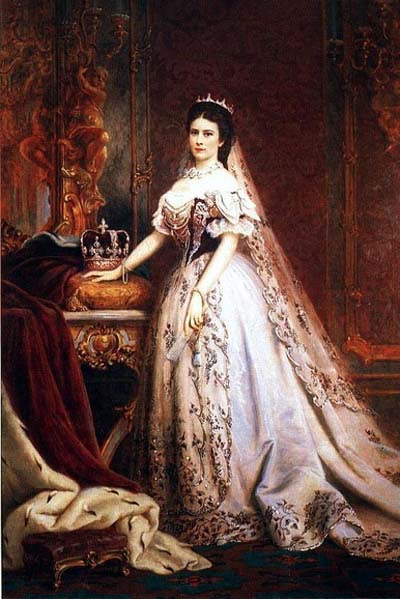I do not like dubbed movies. Although I know there have been some genial ones, nevertheless much is lost in dubbing: both the character and the impression of the foreign sound, the reception skills are narrowed, the foreign language becomes a white noise and its interesting sound will not awake your desire to learn it – and this also weakens the awareness of your mother tongue and the wish to know and use it better.
Many times I tried to imagine how Italians might listen to the Italian operas performed by foreign artists. How does the same aria sound in a learned but “only learned” mouth? What flavor might they feel? Now it seems that I received some kind of an answer to this question.
Around Christmas we saw again – of course, dubbed – the classical Sissi trilogy, whose second part, Sissi – Die junge Kaiserin, if watched without dubbing, has some extra surprise for the Hungarian viewer. (The surprise is not that you eventually might consider it as an authentic historical movie…)
In very few movies you can see mother and daughter playing together – a mother and a daughter. However, in this movie the actress Magda Schneider, of Hungarian ancestry, and featuring Princess Ludovica, plays together with Rosemarie Magdelena Albach-Retty – her daughter.

Despite his foreign-sounding name, Svetislav Petrovich – who acts as Miksa Falk in the movie – was a well-known and favored superstar in pre-1945 Hungarian theaters and movies, an actor already participating in Hungarian silent movies (and since then unjustly forgotten together with all his colleagues).
He and others speak in Hungarian in the German-language film. And you can also hear the Hungarian hymn, chorals by Liszt and other Hungarian songs – in Hungarian.
…and the choir of Vienna also sings – in Hungarian. It is perhaps not surprising that only one historical Hungarian county has the wrong name on the board: Mármaros instead of Máramaros (today Maramureș, Romania).

The film was presented in December 1956. The above song recalls the memory of the synchronic history…



…just as the history of synchron also pushes itself forward at the end of the film. Queen Elizabeth, the legendary grande dame of Hungarians takes oath in Hungarian at the end of the film. We already know that Romy Scheider might have been familiar with Hungarian language. We also hear the Hungarian hymn, with a surprisingly vibrant (and probably original) accompaniment and with some minor errors.
 Romy Schneider 1938-1982
Romy Schneider 1938-1982
Mindent meg fogok tenni, ami hatalmamban áll, hogy a magyar nemzetet boldoggá tegyem.
(I will do everything that is in my power to make the Hungarian nation happy.)

 Queen Elizabeth. 1837-1898 (painting by Bertalan Székely)
Queen Elizabeth. 1837-1898 (painting by Bertalan Székely)
Many times I tried to imagine how Italians might listen to the Italian operas performed by foreign artists. How does the same aria sound in a learned but “only learned” mouth? What flavor might they feel? Now it seems that I received some kind of an answer to this question.
Around Christmas we saw again – of course, dubbed – the classical Sissi trilogy, whose second part, Sissi – Die junge Kaiserin, if watched without dubbing, has some extra surprise for the Hungarian viewer. (The surprise is not that you eventually might consider it as an authentic historical movie…)
In very few movies you can see mother and daughter playing together – a mother and a daughter. However, in this movie the actress Magda Schneider, of Hungarian ancestry, and featuring Princess Ludovica, plays together with Rosemarie Magdelena Albach-Retty – her daughter.
Despite his foreign-sounding name, Svetislav Petrovich – who acts as Miksa Falk in the movie – was a well-known and favored superstar in pre-1945 Hungarian theaters and movies, an actor already participating in Hungarian silent movies (and since then unjustly forgotten together with all his colleagues).
He and others speak in Hungarian in the German-language film. And you can also hear the Hungarian hymn, chorals by Liszt and other Hungarian songs – in Hungarian.
– Igen, igen ez volna a legjobb. – Nem, nem. Ha Andrássy azt mondja, hogy menjünk, akkor megyünk (No, it’s impossible. We should say goodbye to her. – Yes, this would be the best. – No, no. If Andrássy says we should go, then we should go. |
(Come on, folks, hurry! The Queen is coming!) |
The film was presented in December 1956. The above song recalls the memory of the synchronic history…
…just as the history of synchron also pushes itself forward at the end of the film. Queen Elizabeth, the legendary grande dame of Hungarians takes oath in Hungarian at the end of the film. We already know that Romy Scheider might have been familiar with Hungarian language. We also hear the Hungarian hymn, with a surprisingly vibrant (and probably original) accompaniment and with some minor errors.
Mindent meg fogok tenni, ami hatalmamban áll, hogy a magyar nemzetet boldoggá tegyem.
(I will do everything that is in my power to make the Hungarian nation happy.)
| Isten áldd meg a magyart! Jó kedvvel és bőséggel (sic) Nyújts feléje védő kart, Ha küzd ellenséggel, Balsorsa kit régen tép Hozz reá (sic) esztendőt! Megbűnhődte már e nép, Múltat, jövendőt! (sic) | God bless the Hungarian! With cheerfulness and abundance Give them your protective arm, When they fight with an enemy. Oppressed since long by bad fate: Bring them a happy year! This people has already suffered Both for the past and the future |
No hay comentarios:
Publicar un comentario